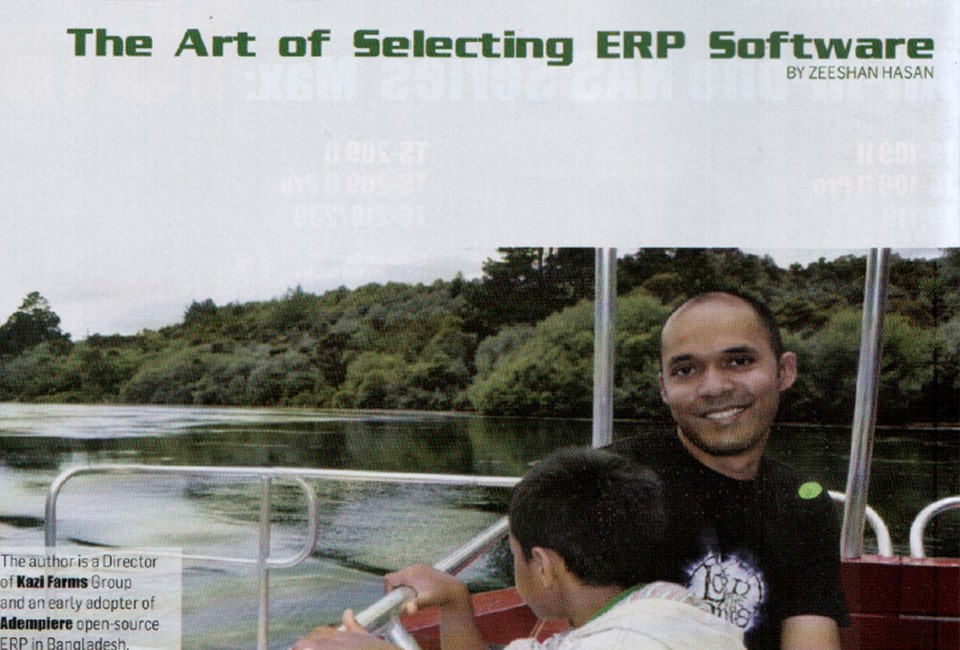The art of ERP software selection
By Zeeshan Hasan
(From the October 2011 edition of CIO magazine, Bangladesh edition.)
One of the natural difficulties of a company which has quickly grown from a small size is that it is likely to have its accounting software centralized in a single head office with no distributed accounting or management information system. This sort of legacy accounting system becomes harder and harder to manage as the number of purchase, production and sales locations increases, simply due to the difficulty and delay of manually moving information from various locations to the head office and then processing it in the centralized accounting system. Furthermore, in a situation where purchase, sales, accounts and manufacturing all maintain separate records systems which are not integrated, any error anywhere creates a discrepancy which is difficult to locate and correct. In this respect, rapidly growing Bangladeshi businesses are now experiencing the same problems that companies in the West have been dealing with since the 1980s. The experience of the MIS and management disciplines in developed countries fortunately reveals the solution to the above problem in the form of Enterprise Resource Planning (ERP) software.
Almost everyone has heard of ERP software, but not many are clear about what it does. Primarily, ERP systems integrate all corporate operations and data, including purchase, inventory, manufacturing, sales, accounts, costing and human resources. Modern ERP systems are generally web-based to enable easy access for from multiple locations. Since all information is stored in a central database, everyone always sees the same data and there is no disagreement between figures used by different departments.
Due to the communication difficulties inherent in a big organization, large and even medium sized companies will see the need for ERP software sooner or later. However, this creates a difficult decision; which ERP system is best? The choice is quite bewildering. On the high end of the market there are the established multinational ERP providers such as SAP, Oracle and Microsoft, which have comprehensive functionality proven over thousands of client installations. However, they come at a steep price, invariably costing thousands of dollars per user in up-front software licence costs, as well as hefty customization costs by foreign experts who stay in five-star hotels. At the low end of the market there are local Bangladeshi software companies offering much cheaper solutions, usually costing in the region of tens of lakhs of Takas; however, these can be a risky proposition, having usually been developed for and deployed by only a handful of customers in a limited range of industries. With all due respect to the Bangladeshi software industry, these local solutions cannot really be considered to be proven, general-purpose ERP software, since they simply haven’t been tested in enough varied business contexts. Relying on an unproven, untested ERP system is indeed dangerous, since once an ERP is implemented, every department in a company is dependent on it; major bugs in the system could throw the entire company into chaos.
Obviously both high-end and low-end ERP systems have major disadvantages in terms of cost and risk respectively. Fortunately, a new alternative has emerged as a mid-range compromise; namely open-source ERP software. Open-source software such as the Firefox web browser, LibreOffice word processor, spreadsheet and presentation suite, and the Linux operating system are developed by international teams of programmers collaborating on shared source code which is downloadable from the internet. The successes of these open-source projects have proven over the last decade that the open-source development process is capable of producing high-quality software comparable to the best proprietary products. The open-source software revolution is now beginning to penetrate the ERP space as well.
The major open-source ERP systems such as Adempiere and Openbravo have a simplified but comprehensive feature set comparable to the proprietary ERP products, providing web-based integrated business software which can be downloaded and used without any software license fee. However, implementing ERP will never be free, regardless of the licence cost; this is because each customer requires their ERP software to be customized to their business needs. Therefore ERP software providers need to charge money for software customization, regardless of the license cost of the software. Nonetheless, open-source ERP still can save a lot of money, and can even compare to the low cost of locally produced ERP companies if sufficient open-source ERP expertise is available locally. Furthermore, open source solutions have a big advantage in they have been implemented in hundreds of diverse businesses around the world, and can truly claim to be proven, general purpose business software that will work in any real business setting.
Open source ERP does not just differ from proprietary ERP in terms of license fees; the common feature of all open-source software is that it gives the customer more choice. For example, one can simply download and use a community-supported open-source Linux operating system such as Debian without paying anyone; or, if corporate support is desired, one can choose to buy Red Hat Linux and pay the Red Hat company for the desired services. Similarly, open-source ERP gives the user the choice whether to go with a community-supported or corporate supported version. A short history of a few of the major open-source ERPs will clarify these choices.
The first fully functional open-source ERP product was Compiere ERP, which was produced and supported by Compiere Incorporated in the USA in 2000. However, it initially lacked a web user interface; hence the Compiere open-source code was forked by the Openbravo company in Spain. The Openbravo company added a web user interface and now markets the resulting ERP product as the Openbravo ERP system. Compiere Inc. was then acquired by Consona, a proprietary ERP company, resulting in large portions of its code (including web user interface and manufacturing module) no longer being fully open source and downloadable. This left Openbravo as the remaining commercially supported open-source ERP derived from Compiere. However, the user community of Compiere again forked the code to create the Adempiere open-source ERP project, adding their own community supported web user interface and other features. So now there are two open-source Compiere derived products; the corporate-supported Openbravo and the community-supported Adempiere. Adempiere and Openbravo are both very similar, having been derived from the original Compiere code; both are developed in Java and use Compiere’s concept of a data dictionary which enables customization to be done quickly with little programming and no bugs introduced by fresh programming.
Which is better, a community-supported open-source project like Adempiere, or a company-sponsored open-source product like Openbravo? There is not a simple answer.
Company-sponsored ERPs have an clear element of leadership and accountability provided by the sponsoring company; but there is a cost for this. The Openbravo company does charge money in the form of annual per user support fees. With company-sponsored open source ERP products, there is also always the risk that the sponsoring company will be acquired by an entity not interested in continuing open-source development, as happened to Compiere.
Community sponsored projects like Adempiere may not have a single company making decisions, which can result in lack of direction. Since there is no single company backing the product, it could be difficult to find high quality support and technical expertise for a community-supported product; in fact, availability of support and expertise should always be the deciding factor for any ERP implementation, as poor support will invariably lead to problems . As opposed to the uncertainty over support, there is the long-term guarantee that the ERP software will always be free, as no one entity can claim ownership of it.
Ultimately the decision of whether to go for a proprietary ERP, commercially-supported open-source ERP or community-supported open source ERP is a judgement call that the customer has to make based on their own IT department skills and availability of local support. A table below summarizes some of the costs and benefits of each.
| ERP System | Type | Includes web interface for purchase, inventory, sales and accounts? | Includes manufacturing? | Initial license cost + annual support cost |
|---|---|---|---|---|
| Oracle, SAP, Microsoft | Proprietary | Yes, at high cost | Yes, at high additional cost | $3000 to $6000 per named user initially + 15% to 20% per year |
| Openbravo | Commericially supported open-source | Yes, for 365 Euros per user per year | Yes, for 500 Euros per user per year | No initial license fee, 365 to 500 Euros per month per concurrent user |
| Adempiere | Community supported open-source | Yes | Yes | No initial license or annual support fees |
Please note that the above table only mentions license and support fees, not customization fees. All ERP systems will require customization fees, and the cost of customization is likely to be substantial for a large organization, regardless of which ERP system is used. Customization cost is likely to depend more on the complexity of the business processes involved, as well as the skills and experience of the company providing the ERP consulting and implementation services.
In spite of many challenges, Bangladesh has been growing. As a result, a number of sectors have expanded rapidly in the last decade or two; including telecoms, garments, textiles, food products, pharmaceuticals, real estate, steel, cement, ceramics, etc. This has naturally created a need for better management and financial control within many rapidly growing companies. Increasing adoption of ERP systems is going to be inevitable as we go forward; as that happens, more and more companies will be faced with the choice of which ERP system to use. Hopefully this article will give people some guidance when they come to that decision.




